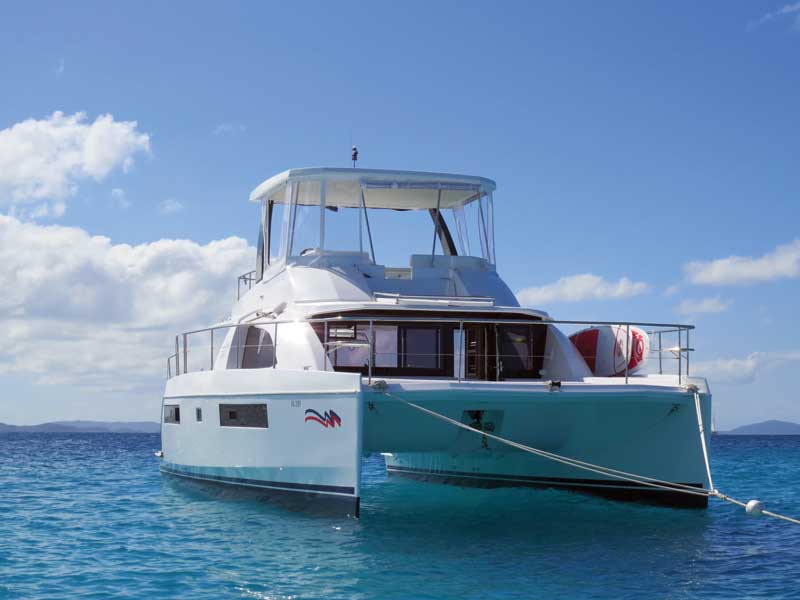Last month, we introduced our three-part series on beginning chartering which included the first part on managing the decisions and bureaucracy of embarking on a charter vacation. This leaves us with two more installments: managing the model of boat you’re likely to encounter on charter, and not being intimidated by the long checklist of the crazy first day. Here in Part II, we’ll dive into the specifics of the charter boat.

Kinds of boats
Chartering can mean just about anything. Maybe you’ve rented a boat through a sharing service like Boatsetter and you’ll be driving a 25-foot pontoon or a 35-foot day cruiser in your local waters. Or maybe, you’ll charter a center console and go bone fishing in the Florida Keys. All these day boats will drive differently but most are under 40 feet and will likely have single or double outboard motors, so they’re fairly easy to manage.
If you’re set on a longer cruising charter such as in the Pacific Northwest, you may find single or twin-screw diesel inboard engines on monohull powerboats like those with the Anacortes Yacht Charter fleet. These boats are bigger and possibly more complex, but they may mirror what you already drive back home, so they’re familiar. If you go overseas with one of the major charter companies to explore destinations like Croatia, Tahiti, Martinique, or the Sea of Cortez, you’ll most likely be on a powercat.
The Moorings, Dream Yacht Charters, and MarineMax Vacations all offer powercats from 35-55 feet, and some monohullers find these big platforms intimidating. But here’s my first tip: these boats are actually easier and more fun to drive, so there’s no need to worry. They offer stability, space, and better privacy, so your crew will love a cat.
Powercats on the rise
Powercats are a fast-growing segment of boating. They’re great for shallow waters due to their limited draft and popular with large groups because of their wide decks and private cabin space. Family members prone to seasickness may feel less queasy on a stable powercat that has a different motion than a monohull, and you’re likely to spend less on fuel since these boats are more efficient overall.
Cats are also easier to drive once you get used to commanding something the size of your living room. Two engines set wide apart make close-quarters maneuvering a snap which means you can dock like a pro. If you have a friend with a cat, ask for a lesson before your charter or just have the checkout captain walk you through it. Here’s my second tip: when driving a cat in a tight situation, center and lock the wheel and focus strictly on the engines. Wheel steering while using the throttles will only make things more confusing, and cats respond better to the power of wideset engines than they do to the small rudders controlled by the wheel. Go easy on the throttles or use one engine at a time rather than jamming one in forward and one in reverse and just bubbling in your own cavitation.

More benefits of powercats
Cats tend to have more of everything including fresh water, fuel, and battery capacity. Cats also offer systems redundancy, so if a freshwater pump fails in one hull, chances are you’ll still be able to take showers on your vacation in the other hull. And you can also limp back to base on one engine.
These big boats have space for lots of people and all their stuff as well as for extra systems. Many charter powercats come standard with generators which enable the use of watermakers and A/C. And most cats have davits, so you carry your tender rather than drag it behind the boat which is both safer and more fuel efficient.
Finally, mooring and anchoring a cat is usually easier because there’s typically a pre-set bridle on the anchor which will keep the boat centered on the chain.
Downsides of powercats
Even small cats feel big which can make first-timers nervous. Visibility is usually a tradeoff. Cats with bulkhead-mounted helms can make seeing both bows challenging, but they offer good sightlines aft which is important when docking since you’ll want to bring a cat in backwards for easier boarding. On the other hand, cats with flybridges offer good visibility forward but just about none aft, especially if the helm is on the centerline. You’ll need to rely on good communication with the crew who will be your eyes in different corners of the boat.
Another issue with the size and specifically the beam of a cat is finding a place to dock one, especially in the small harbors and town quays of Europe. Med mooring a cat is actually easier from a control standpoint, but being able to wiggle a 23-foot beam onto the wall during the summer tourist season is another matter. That said, catamaran charters have exploded in the Mediterranean over the past five years, so they’re not as oddball as they once were.
Finally, powercats also tend to be more expensive to charter and not available at every destination. In that case, here’s my third tip: consider chartering a sailing cat because here’s the secret—many sailing charterers never raise the sails anyway and by day three, they’re just racing from one snorkel spot to another under power alone.
Let the company guide you
Most charter powercats offer four cabins and two to four heads, so you can opt for 40 feet rather than 50 and still enjoy much of the same crew comfort without feeling like you’re driving an aircraft carrier. Let the charter reps guide you in your selection and the boat’s outfitting, and you may come back from charter a powercat convert.
By Zuzana Prochazka